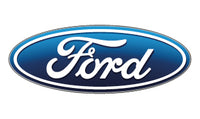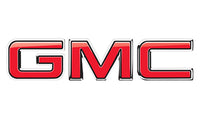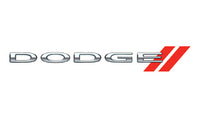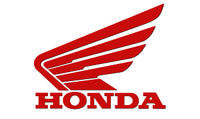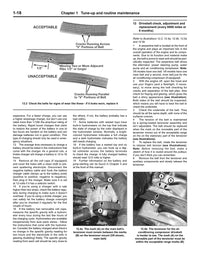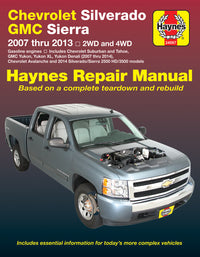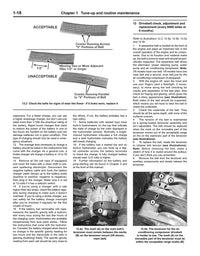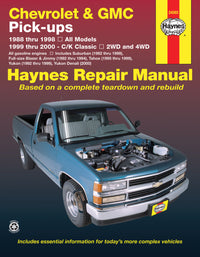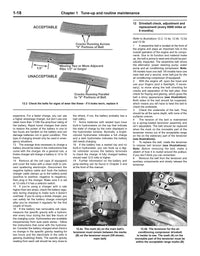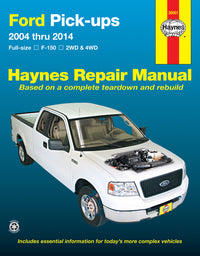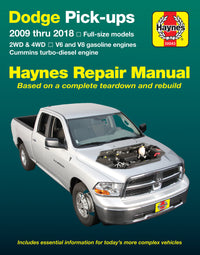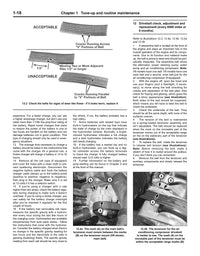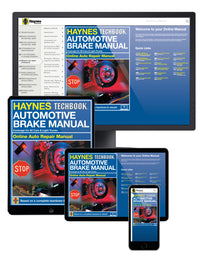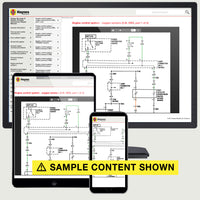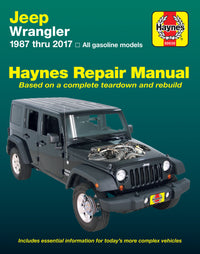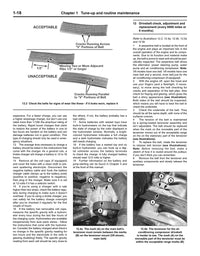The 2004-2014 Ford F-150 pickup truck is the epitome of tough, but it still needs to be maintained. Here's our quick guide, taken directly from Haynes manual 36061.
If you need more guidance, or even step-by-step instructions and a video demonstration, get the online manual, or our traditional printed manual.
Oil Change
| Oil type | API “certified for gasoline engines,” synthetic |
| Oil viscosity | SAE 5W-20 |
| Oil capacity (including filter) | |
| V6 engines | 6.0 quarts |
| V8 engines | |
| 4.6L | 6.0 quarts |
| 5.0L | 6.0 quarts |
| 5.4L | 7.0 quarts |
| 6.2L | 7.0 quarts |
| Recommended fastener torque | |
| Oil drain plug | |
| V6 engines | |
| 2010 and earlier V6 engines | 17 ft-lbs |
| 3.5L and 3.7L V6 | 20 ft-lbs |
| V8 engines | |
| 2010 and earlier V8 engines | 120 in-lbs |
| 5.0L V6 | 19 ft-lbs |
| 6.2L V8 | 17 ft-lbs |
Transmission Fluid Change
| Automatic transmission fluid type | |
| Four-speed transmission | MERCON® V automatic transmission fluid |
| Six-speed transmission | MERCON® LV automatic transmission fluid |
| Manual transmission lubricant | MERCON® automatic transmission fluid |
| Caution: Be sure to use the correct type of transmission fluid. Do not mix MERCON® and MERCON® V or LV | |
| Automatic transmission fluid capacity (dry fill) | |
| 2004-2010 | |
| Four-speed transmission | Up to 13.9 quarts |
| Six-speed transmission | Up to 10.1 quarts |
| 2011 and later | Up to 13 quarts |
| Note: This is a dry-fill specification so the amount for a routine fluid change will be substantially less. Determine the amount of fluid to add by measuring the amount drained, initially add 1/3 of that amount. Then, with the engine running, add 1/2-pint at a time (shifting through each gear position between additions) until the level is correct. It is important to not overfill the transmission. | |
| Manual transmission fluid capacity | Up to 3.75 quarts |
| Recommended fastener torque | |
| Automatic transmission pan bolts | 120 in-lbs |
| Manual transmission | |
| Fill plug | 35 ft-lbs |
| Drain plug | 35 ft-lbs |
Transfer Case and Differential Fluid Change
| Fluid type | |
| Transfer case | MERCON® automatic transmission fluid |
| Rear differential** | |
| 2004 models | SAE 75W-90 Motorcraft High Performance Synthetic Rear Axle Lube or equivalent. |
| 2005 and later models | SAE 75W-140 Motorcraft High Performance Synthetic Rear Axle Lube or equivalent. |
| Front differential | SAE 75W-90 Motorcraft High Performance Synthetic Rear Axle Lube or equivalent. |
| Caution: Be sure to use the correct type of transmission fluid. Do not mix MERCON® and MERCON® V or LV | |
| Fluid Capacity | |
| Transfer case | Up to 2.9 quarts |
| Rear differential | |
| 8.8/9.75 inch axle | Up to 5.5 pints |
| 10.25 inch axle** | Up to 6.9 pints |
| **Traction-Lock limited slip differentials add 6.5 pints of SAE 75W-140 and 8 oz. of friction modifier XL-3 (2004-2010 models) or 4 oz. of modifier (2011 and up). | |
| Recommended fastener torque | |
| Transfer case | |
| Transfer case fill and drain plugs | 18 ft-lbs |
| Front differential | |
| Cover bolts | 24 ft-lbs |
| Fill plug | 18 ft-lbs |
| Rear differential | |
| Cover bolts | 33 ft-lbs |
| Check/fill plug | 22 ft-lbs |
Cooling System Flush and Fill
| Coolant type | |
| 2010 and earlier models | Motorcraft Premium Gold Engine Coolant (yellow colored) |
| 2011 and later models | Motorcraft Orange Engine Coolant (orange colored) |
| Cooling system capacity | |
| Pushrod V6 engines | 17.6 quarts |
| OHC V6 engines | |
| 3.5L | 16.5 quarts |
| 3.7L | 16.0 quarts |
| V8 engines | |
| 4.6L | 20.5 quarts |
| 5.0L | 17.0 quarts |
| 5.4L | 20.9 quarts |
| 6.2L | 19.5 quarts |
| Caution: Do not mix coolants of different colors. Doing so might damage the cooling system and/or the engine. The manufacturer specifies a gold colored coolant to be used in these systems. | |
Other Miscellaneous Fluid Types
| Brake fluid type | DOT 3 brake fluid |
| Clutch fluid type | DOT 3 brake fluid |
| Power steering fluid | MERCON® automatic transmission fluid |
Other Miscellaneous Torque Specs
| Spark plugs | |
| V6 engines | 132 in-lbs |
| V8 engines | |
| 4.6L | 132 in-lbs |
| 5.0L | 124 in-lbs |
| 5.4L | 25 ft-lbs |
| 6.2L | 159 in-lbs |
| Drivebelt tensioner mounting bolt(s) | |
| V6 engines | |
| 2010 and earlier V6 engines | 41 ft-lbs |
| 3.5L and 3.7L V6 | 18 ft-lbs |
| V8 engines | |
| 2010 and earlier V8 engines | 18 ft-lbs |
| 5.0L V8 | 35 ft-lbs |
| 6.2L V8 | 18 ft-lbs |
| Wheel lug nuts | 150 ft-lbs |
| Brake caliper mounting bracket bolts | |
| Front | |
| 2004 through 2008 models | 148 ft-lbs |
| 2009 models | 136 ft-lbs |
| 2010 and later models | 184 ft-lbs |
| Rear | |
| 2008 and earlier models | 60 ft-lbs |
| 2009 through 2011 models | 122 ft-lbs |
| 2012 and later models | 111 ft-lbs |
| Brake caliper mounting bolts | |
| Front (guide pin bolts) | |
| 2004 models | 47 ft-lbs |
| 2005 through 2009 models | 55 ft-lbs |
| 2010 and later models | 27 ft-lbs |
| Rear | |
| 2004 through 2011 models | 22 ft-lbs |
| 2012 and later models | 24 ft-lbs |

Maintenance Schedule
The following intervals are based on the assumption that you will be doing the service work yourself, as opposed to paying to have the work done. These are our recommended minimum maintenance intervals for vehicles that are driven daily, and in many cases are shorter than the factory’s recommendations. Because frequent maintenance enhances the efficiency, performance and resale value of your Jeep, we encourage you to follow our schedule. If you drive in dusty areas, tow a trailer, idle or drive at low speeds for extended periods, or drive for short periods (less than four miles at a time) in below freezing temperatures, even smaller intervals are recommended.
When the vehicle is new, follow the maintenance schedule to the letter, record it in your owner’s manual and keep all receipts to protect the warranty and resale value. In many cases the initial maintenance check is done by the dealer at no cost (check with the service department when you buy the truck for more information).
Every 250 miles or weekly, whichever comes first
- Check the engine oil level
- Check the engine coolant level
- Check the brake and clutch fluid level
- Check the windshield washer fluid level
- Check the power steering fluid level
- Check the automatic transmission lubricant level
- Check the tires and tire pressures
Every 3000 miles or 3 months, whichever comes first
All items listed above plus:
- Change the engine oil and oil filter
- Rotate the tires
- Check the manual transmission lubricant level
- Check the transfer case lubricant level (4WD models)
- Check the differential lubricant level
Every 7500 miles or 6 months, whichever comes first
All items listed above plus:
- Inspect and replace, if necessary, the windshield wiper blades
- Check and service the battery
- Check the cooling system
- Check the seat belts
Every 15,000 miles or 12 months, whichever comes first
All items listed above plus:
- Inspect and replace, if necessary, all underhood hoses
- Inspect the brake system*
- Inspect the suspension and steering components
- Fuel system check
- Inspect and replace, if necessary, air filter*
Every 30,000 miles or 24 months, whichever comes first
All items listed above plus:
- Check the exhaust system
- Replace the fuel filter
- Replace the air filter*
- Change the brake fluid
- Check the engine drivebelt
Every 60,000 miles or 48 months, whichever comes first
All items listed above plus:
- Replace manual transmission lubricant*
- Replace the Positive Crankcase Ventilation (PCV) valve
- Check and replace, if necessary, the spark plugs
- Check the ignition coils (V8 engines)
- Inspect and replace, if necessary, the spark plug wires (V6 engines)
- Replace the differential lubricant*
Every 100,000 miles
- Service the cooling system (drain, flush and refill)
- Replace the automatic transmission fluid**
- Replace the transfer case lubricant
- Replace the spark plugs
* This item is affected by “severe” operating conditions as described below. If your vehicle is operated under severe conditions, perform these maintenance tasks at 3000 miles/3 month intervals. Severe conditions include the following:
- Operating in mostly dusty areas (dirt roads, or off-road)
- Idling for extended periods and/or low speed operation
- Mostly short trips (less than 4 miles) when outside temperatures remain below freezing
** If operated under one or more of the following conditions, change the automatic transmission fluid every 15,000 miles.
- In heavy city traffic where the outside temperature is regularly above 90-degrees F (32-degrees C)
- In hilly or mountainous terrain
- Frequent trailer towing
- Frequent off road use
